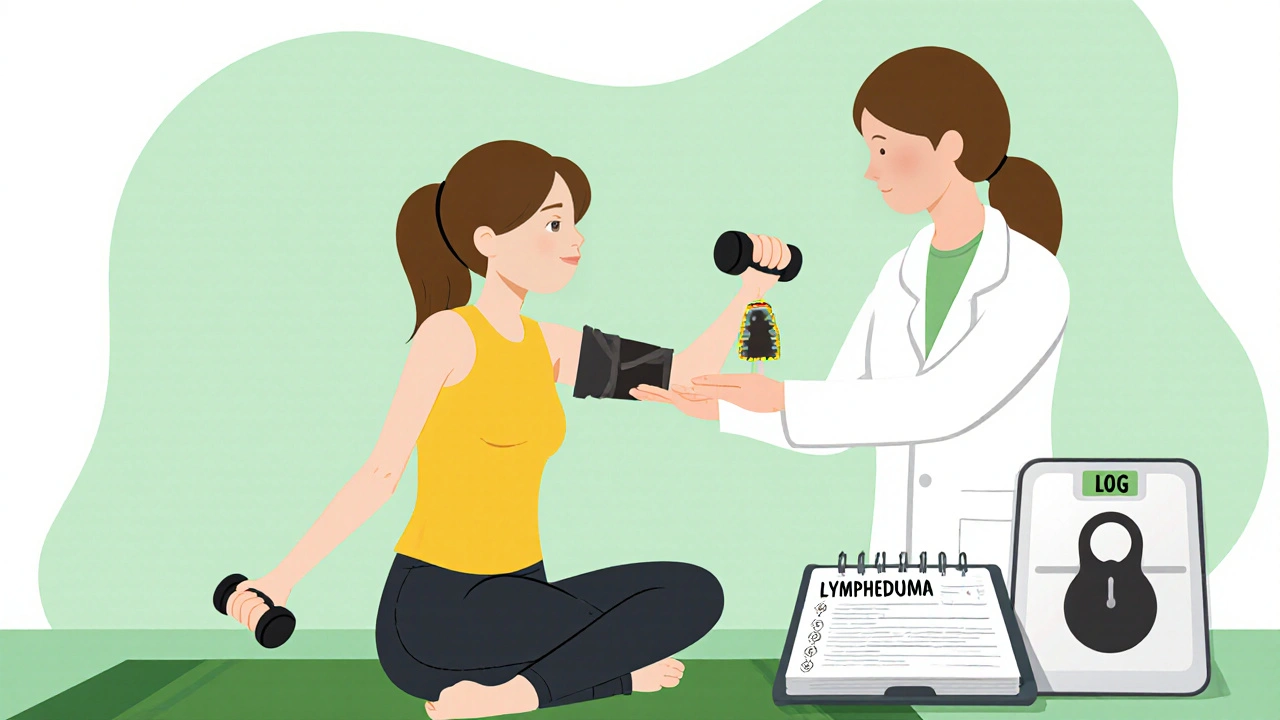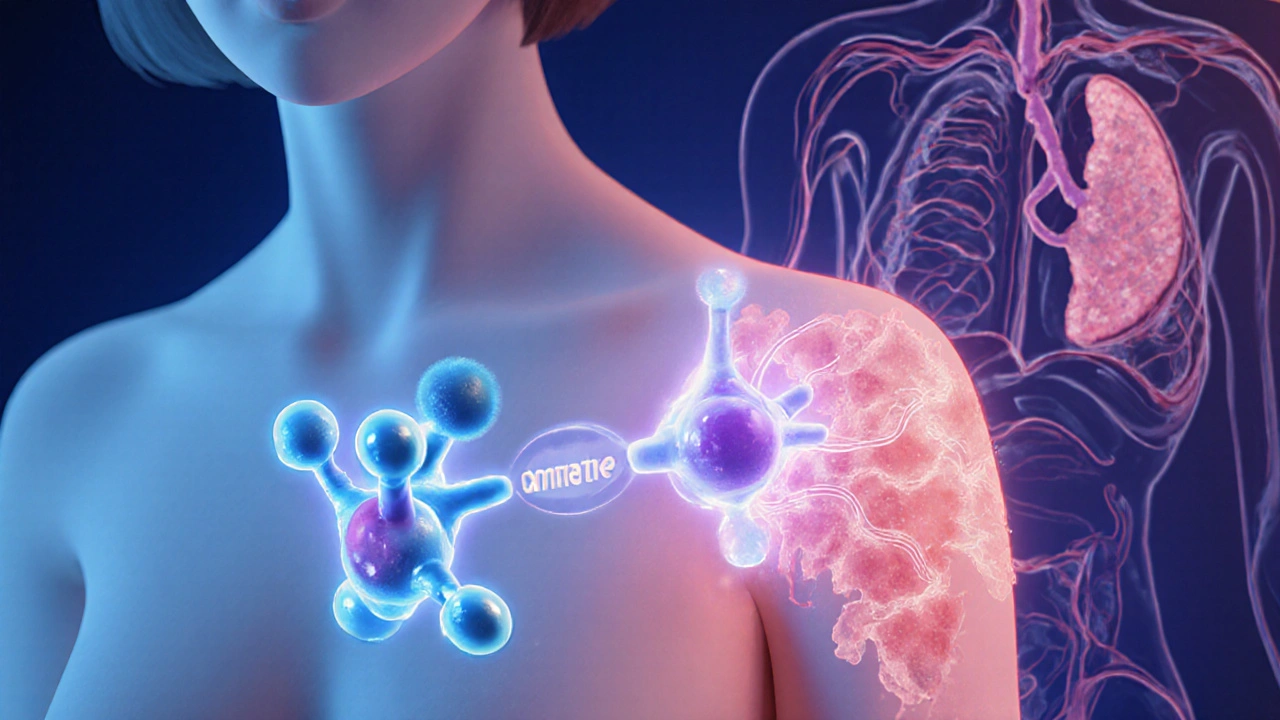When you hear the name Exemestane is a steroidal aromatase inhibitor used after surgery or radiation to lower estrogen levels in estrogen‑receptor‑positive breast cancer patients. It’s praised for its efficacy, but a growing number of women notice swelling in their arms or legs that isn’t just ordinary edema. That swelling is called Lymphedema, a chronic buildup of lymph fluid that can happen after cancer treatment.
Understanding how these two conditions intersect can spare you from months of frustration and unnecessary doctor visits. Below you’ll find a step‑by‑step walk‑through of the biology, risk factors, warning signs, and practical ways to keep lymphedema under control while staying on exemestane.
How Exemestane Works
Exemestane belongs to the Aromatase Inhibitor class, which blocks the enzyme aromatase that converts androgens into estrogen. By cutting estrogen production, it starves hormone‑sensitive breast cancer cells, slowing or stopping tumor growth. Unlike some other aromatase inhibitors that are non‑steroidal, exemestane is a “suicide inhibitor”-it permanently disables the enzyme, leading to a steadier drop in estrogen levels.
What Is Lymphedema?
The Lymphatic System is a network of vessels and nodes that transports fluid, proteins, and immune cells back to the bloodstream. When surgery removes lymph nodes (often under the arm during a mastectomy) or radiation damages them, the flow can back up, causing fluid to pool. This results in Lymphedema, which feels heavy, tight, and sometimes painful.
Why Exemestane Might Trigger Lymphedema
- Hormonal Influence: Estrogen helps keep blood vessels flexible and supports lymphatic contractility. Dropping estrogen sharply with exemestane can reduce the pumping action of lymph vessels.
- Inflammatory Pathways: Aromatase inhibition may alter cytokine levels, increasing inflammation around healed tissue and making fluid leakage more likely.
- Combined Therapies: Many patients receive exemestane after surgery and radiation-both known lymphedema risk factors. The drug can tip the balance for someone already on the edge.
Who Is Most at Risk?
Not everyone on exemestane will develop lymphedema. The following groups see higher odds:
- Women who had axillary lymph node dissection (removal of many nodes) rather than a sentinel‑node biopsy.
- Patients who received radiation to the under‑arm or chest wall.
- Those with a BMI over 30 - excess tissue adds pressure on lymph channels.
- Individuals with a family history of lymphedema or prior episodes after other cancer treatments.
Spotting Early Signs
Early detection makes management far easier. Look for these clues within the first few weeks to months of starting exemestane:
- A feeling of heaviness or fullness in the arm, hand, or leg, even if the skin looks normal.
- Increased tightness when wearing a sleeve or shoe.
- Swelling that worsens after a long flight, a hot shower, or a day of standing.
- Occasional throbbing or aching that improves with gentle elevation.
If you notice any of these, grab a measuring tape and record the circumference at a consistent spot (for example, 10 cm above the elbow). A rise of 2 cm or more over a week is a red flag.
Managing Lymphedema While Staying on Exemestane
Stopping a life‑saving breast‑cancer drug is rarely the first step. Instead, adopt a multi‑pronged approach:
- Compression Therapy: Wear a well‑fitted compression sleeve or stockings during the day. Start at a moderate pressure (20‑30 mm Hg) and adjust based on comfort.
- Manual Lymphatic Drainage (MLD): This gentle massage, performed by a certified therapist, moves fluid toward healthy lymph nodes. Sessions once a week can keep swelling at bay.
- Exercise: Light resistance training (e.g., arm curls with a 1‑kg weight) improves muscle pump action. Aim for 30 minutes of low‑impact activity most days.
- Skin Care: Keep the affected area clean and moisturized. Small cuts can become infections that worsen lymphedema.
- Weight Management: Even a modest 5 % weight loss reduces pressure on lymph channels.
- Monitoring: Keep a weekly journal of limb measurements, symptoms, and any triggers. Share this with your oncology nurse.
Many patients find relief within a month of adding these habits. If swelling persists despite diligent effort, talk to your oncologist about a possible dose adjustment or switching to another aromatase inhibitor.

Comparing Aromatase Inhibitors for Lymphedema Risk
| Drug | Mechanism | Reported Lymphedema Rate | Typical Dose |
|---|---|---|---|
| Exemestane | Steroidal “suicide” inhibitor | ~5‑7 % (observational studies) | 25 mg daily |
| Anastrozole | Non‑steroidal reversible inhibitor | ~3‑4 % (meta‑analysis) | 1 mg daily |
| Letrozole | Non‑steroidal reversible inhibitor | ~2‑3 % (phase‑III trials) | 2.5 mg daily |
While none of these drugs are intrinsically “safe” from causing lymphedema, exemestane’s slightly higher rate may be tied to its stronger estrogen suppression. If you have multiple risk factors, a clinician might prefer anastrozole or letrozole and monitor closely.
When to Talk to Your Doctor
Schedule a check‑in if:
- Swelling persists for more than two weeks despite compression.
- You notice skin changes: redness, hardening, or frequent infections.
- Pain becomes constant rather than intermittent.
- You’re unsure about the correct compression level or fit.
Doctors may order a lymphoscintigraphy scan to map fluid flow, or they might refer you to a certified lymphedema therapist. In rare cases, they could pause exemestane for a short period to see if symptoms improve.
Key Takeaways
- Exemestane lowers estrogen, which can weaken lymph‑vessel pumping and raise lymphedema risk.
- Risk spikes after extensive node removal, radiation, or high BMI.
- Detect swelling early with regular measurements and symptom logs.
- Compression, gentle exercise, and manual drainage are frontline defenses.
- If swelling doesn’t improve, discuss dose tweaks or alternative aromatase inhibitors with your oncologist.
Can exemestane cause lymphedema on its own, without surgery?
Rarely. Most cases occur after surgery or radiation that already compromised the lymphatic network. However, the drug’s estrogen‑lowering effect can aggravate a borderline system, so clinicians watch for swelling even in patients with minimal node removal.
Is it safe to wear a compression sleeve while taking exemestane?
Yes. Compression is the most evidence‑based non‑pharmacologic treatment for lymphedema. It does not interfere with exemestane’s anti‑cancer action.
How long does it take to see improvement after starting manual lymphatic drainage?
Some patients notice reduced swelling after a single session, but most need weekly therapy for 4‑6 weeks before measurable changes appear.
Should I stop exemestane if I develop lymphedema?
Stopping abruptly can raise the risk of cancer recurrence. Discuss dose adjustments or a switch to another aromatase inhibitor with your oncologist first.
Are there any nutrition tips that help with lymphedema?
A low‑sodium diet reduces fluid retention. Foods rich in flavonoids-berries, citrus, and leafy greens-support vascular health. Staying well‑hydrated also helps lymph flow.



It is no coincidence that the pharmaceutical companies promote exemestane without warning patients about the hidden risk of lymphedema, a fact they deliberately conceal.
Exemestane’s irreversible binding to aromatase distinguishes it from non‑steroidal agents such as anastrozole. By permanently inactivating the enzyme, serum estrogen falls sharply, often below 10 pg/mL. This profound hypo‑estrogenic state can impair the contractility of lymphatic smooth muscle. Moreover, the concomitant use of radiation further compromises nodal architecture. Clinicians should therefore treat the drug’s potency as a double‑edged sword.
The drug’s side‑effects are not an accidental by‑product; they are a calculated sacrifice imposed by profit‑driven trials. Every swollen arm is a reminder that the industry values market share over patient comfort. Patients deserve transparent risk data, not sanitized pamphlets.
I’ve seen several survivors implement compression sleeves and notice real improvement within weeks. Pairing gentle resistance exercises with manual lymphatic drainage creates a synergistic pump effect. Staying hydrated and limiting sodium also reduces fluid retention. If you can, enlist a certified therapist early to fine‑tune your regimen.
When I started exemestane after my lumpectomy, I thought the swelling was just “post‑surgery” stuff. By week three, my left forearm felt like a water‑balloon and the bracelet I bought felt suffocating. I grabbed a tape measure and logged a 2.5 cm increase around my elbow. The nurse showed me a compression sleeve that actually fit, and I’ve been wearing it ever since. It’s crazy how a simple habit can keep the swelling at bay.